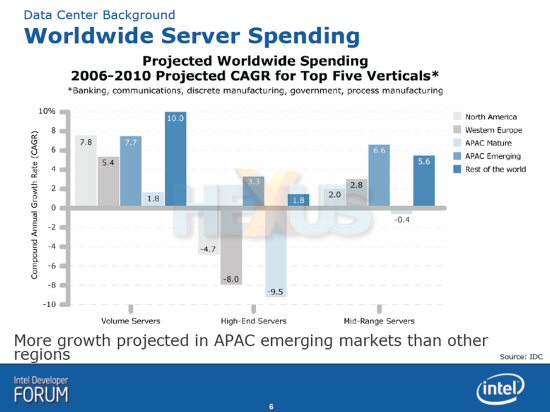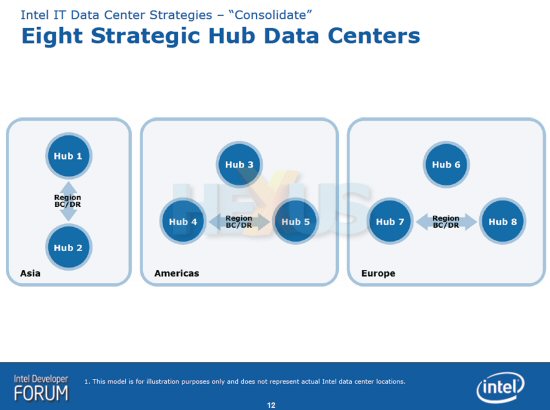Your server costs are going to rise as your servers grow
 The need to safeguard data coupled with massive compute requirements has led to a huge increase and associated growth in data server and storage demand.
The need to safeguard data coupled with massive compute requirements has led to a huge increase and associated growth in data server and storage demand.
Marty Menard, Director of Platform Capability, indicated that Intel, for example, currently has 136 data centres around the world, and that figure is destined to rise by 10 per cent-plus over the next 10 years if left unchecked. However, that's only part of the story, and Intel has a remedy to the spiralling data center costs the company is facing.
Menard noted that whilst Intel's server growth is continuing unabated, server utilisation is actually quite low - around 65 per cent. Simple maths tells us that 35 per cent is not being utilised (duh!), and raising utilisation will limit the need for investing in new equipment.
 Click for larger image
Click for larger imageIn fact, Intel didn't have detailed information on its current data center breakdown until last year. Subsequent research indicated that 62 per cent of Intel data centres were over 10 years old, which tells the informed reader that they're not efficient: Using the same rackspace now, for example, could house Blade servers with multi-core CPUs. Intel reckons that it can replace these older servers on a 4:1 ratio, meaning that 4 older servers can be decommissioned and replaced by a single model now, taking up a far smaller area.
Physically replacing servers with better-performing models is one facet of data center optimisation. The other is virtualisation, which means running multiple, isolated 'virtual' servers - that required a machine each before - on a single, high-performing machine.
 Click for larger image
Click for larger imageIntel's long-term strategy is to consolidate its 130-odd data centres to just 8, which will comprise of larger (mega) centres that house a greater concentration of high-performance servers (multi-core blades that provide 500W+ per square foot). The idea is to design these larger data centres in modular fashion, adding modules if and when required.
 Click for larger image
Click for larger imageThe formula is quite simple, really. The performance-per-watt of quad-core Clovertown processors hooked up in a Blade setup leads to a hugely efficient performance per rack. Add virtualisation to this, which ramps up utilisation, and it translates to the need for lower power for the same level of processing, and smaller floorspace.
Potential drawbacks? Virtualisation is limited by present I/O performance, so it's effective only to a certain point. Further, with so much heat produced per square foot efficient cooling becomes a serious issue. Recycling of disposed equipment can also raise 'green' issues, as well.
Consilidation will become pervasive amongst large companies with multiple data centres, and Intel has already started down that route.













